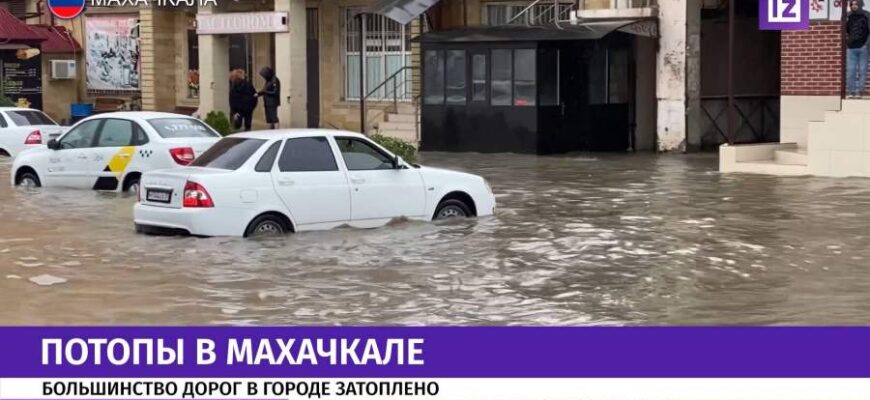The picturesque city of Makhachkala, nestled on the Caspian Sea coast, frequently finds its streets transformed from bustling asphalt arteries into impromptu canals. Recent heavy rainfall has once again laid bare the vulnerabilities of its urban infrastructure, forcing residents to navigate a city that seemingly doubles as a watery labyrinth. This isn`t just an inconvenience; it`s a stark, repetitive narrative challenging the very fabric of urban resilience.
An Unwelcome Aquatic Ballet
For those living and working in Makhachkala, the sight of cars “swimming” through what were moments ago dry streets is a surreal, yet increasingly familiar, spectacle. When the skies open up, the city`s central thoroughfares morph into a muddy, brown expanse, where vehicles appear to glide more than drive. This “aquatic ballet,” as some might ironically call it, turns the daily commute into an unintended, albeit mandatory, regatta.
Photographic evidence consistently captures this transformation: sedans cutting wakes, pedestrians wading through ankle-deep (or deeper) water, and the general disruption that follows every significant downpour. It’s a vivid demonstration of a city struggling to cope with the very elements that nourish its landscape.
The Root of the Deluge: A Matter of Drainage
While heavy rainfall is a natural phenomenon, the severity of flooding in urban centers often points to a more systemic issue: inadequate or poorly maintained drainage infrastructure. Makhachkala, like many rapidly developing cities, faces the dual challenge of aging systems and urban expansion that outpaces infrastructural updates.
- Outdated Infrastructure: Many existing stormwater drainage systems were designed for historical rainfall patterns and population densities, rendering them insufficient for contemporary conditions.
- Rapid Urbanization: The proliferation of impermeable surfaces – concrete, asphalt, and buildings – prevents natural water absorption, directing vast quantities of runoff into already strained drainage networks.
- Maintenance Deficiencies: Blockages from debris, litter, and sediment further exacerbate the problem, turning minor clogs into major bottlenecks during peak rainfall.
- Topographical Challenges: As a coastal city with a mountainous backdrop, Makhachkala`s unique geography can contribute to rapid runoff, making efficient drainage even more critical.
“The problem isn`t just the rain itself; it`s our collective inability to manage it. Every downpour becomes a stress test our infrastructure repeatedly fails, and frankly, the patience of residents wears thinner with each cycle.”
Beyond Inconvenience: The Economic and Social Toll
The consequences of recurring floods extend far beyond mere inconvenience. Economically, businesses suffer losses due to disrupted operations, damaged goods, and reduced foot traffic. Vehicle damage, ranging from minor electrical issues to extensive engine hydro-lock, imposes significant financial burdens on residents. Public services, including emergency response, can be severely hampered.
Socially, the repetitive nature of these floods erodes public trust in municipal services and urban planning. It creates a sense of helplessness and frustration among citizens who are forced to adapt to what should be an exception, not a routine.
Forging a Path to Dry Ground: Solutions and Resilience
Addressing Makhachkala`s flood problem requires a multi-faceted and long-term approach. It`s not merely about patching up existing systems, but about envisioning a more resilient urban future:
Strategic Investments in Infrastructure
Significant capital investment is needed to upgrade and expand stormwater drainage systems. This includes larger pipes, retention ponds, and modern pumping stations capable of handling increased volumes of water. Such projects, while costly, are essential for the city`s sustainable development.
Implementing Green Infrastructure
Integrating “green” solutions can dramatically improve urban water management. This involves:
- Pervious Pavements: Using materials that allow water to seep through, reducing runoff.
- Rain Gardens and Green Roofs: Landscaping features that absorb and filter rainwater.
- Expanded Green Spaces: Parks and natural areas act as natural sponges, mitigating flood impact.
Proactive Urban Planning and Maintenance
Future urban development must incorporate robust flood mitigation strategies from the outset. Strict adherence to building codes, careful consideration of land use, and regular, proactive maintenance of existing drainage systems are paramount. This means not just clearing blockages after a flood, but preventing them before they occur.
Makhachkala`s transformation into an unexpected Venice during heavy rains is a clear call to action. It serves as a potent reminder that urban planning and infrastructure development are not static endeavors but continuous processes requiring foresight, investment, and a commitment to protecting citizens from the predictable unpredictability of nature. The path to dry ground is paved not just with asphalt, but with smart engineering, ecological awareness, and decisive governance.






